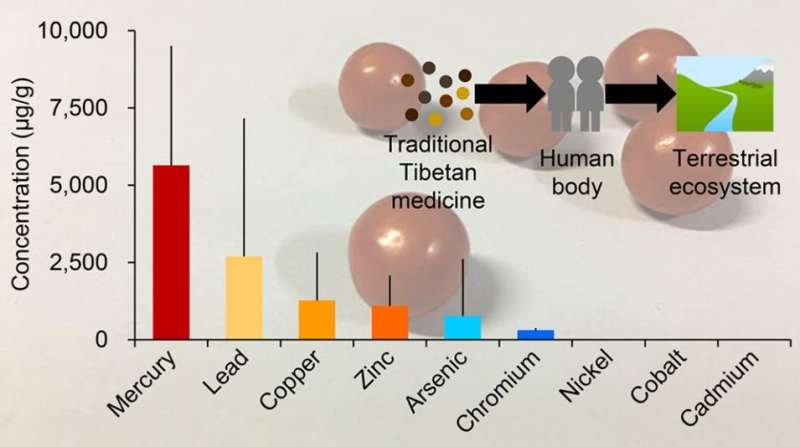Traditional Tibetan medicine exposes people and environment to high mercury levels

Many people view the Tibetan Plateau, or "Roof of the World," as a pristine alpine environment, largely untouched by pollution. But researchers, reporting in ACS' journal Environmental Science & Technology, have now shown that traditional Tibetan medicine (TTM) exposes people and the environment to high levels of mercury and methylmercury.
Used by Tibetans for more than 1,000 years, TTM is a complex concoction of herbs and minerals in pill form. Pharmacists often add minerals to TTM that might contain mercury and other heavy metals in the belief that they have therapeutic effects. High levels of total mercury have been reported in TTM, but until now nobody has analyzed the amount of methylmercury—one of the most toxic forms of the element. Xuejun Wang and coworkers wanted to understand the life cycle of mercury and methylmercury from their ingestion in TTM to their release into the environment.
The researchers began by measuring total mercury and methylmercury concentrations in seven commonly used types of TTM. With this information, they estimated that the average probable daily intake of total mercury by Tibetans was 34-fold higher than in a region of China specializing in mercury mining and 200¬-3,000-fold higher than in Japan, Norway and the U.S. Probable intake of methylmercury was also higher in Tibet than in the other regions, except for in Japan, where high amounts of marine fish (another source of methylmercury) are consumed. In 2015, Tibetans excreted about 1,900 pounds of total mercury, mostly from TTM, into municipal sewage treatment plants and released about 7,900 pounds directly into the environment, the researchers estimated. Only about 3.2 ounces of methylmercury likely entered municipal sewage. However, actual methylmercury levels could be much higher because bacteria in sewage might convert inorganic mercury into the more toxic form, the researchers say.
More information: Traditional Tibetan Medicine Induced High Methylmercury Exposure Level and Environmental Mercury Burden in Tibet, China, Environmental Science & Technology (2018). pubs.acs.org/doi/abs/10.1021/acs.est.8b01754
Abstract
Highly elevated concentrations of total mercury (THg) and methylmercury (MeHg) were found in the municipal sewage in Tibet. Material flow analysis supports the hypothesis that these elevated concentrations are related to regular ingestion of Hg-containing Traditional Tibetan Medicine (TTM). In Tibet in 2015, a total of 3600 kg of THg was released from human body into the terrestrial environment as a result of TTM ingestion, amounting to 45% of the total THg release into the terrestrial environment in Tibet, hence substantially enhancing the environmental Hg burden. Regular ingestion of TTM leads to chronic exposure of Tibetans to inorganic Hg (IHg) and MeHg, which is 34 to 3000-fold and 0−12-fold higher than from any other known dietary sources, respectively. Application of a human physiology model demonstrated that ingestion of TTM can induce high blood IHg and MeHg levels in the human body. Moreover, 180 days would be required for the MeHg to be cleared out of the human body and return to the initial concentration i.e. prior to the ingestion of 1 TTM pill. Our analysis suggests that high Hg level contained in TTM could be harmful to human health and elevate the environmental Hg burden in Tibet.
Journal information: Environmental Science & Technology
Provided by American Chemical Society



















